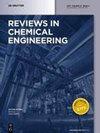Carbomer microgels as model yield-stress fluids
IF 4.9
3区 工程技术
Q1 ENGINEERING, CHEMICAL
引用次数: 25
Abstract
Abstract The review presents current research results for Carbopol-based microgels as yield-stress materials, covering three aspects: chemical, physical and rheological. Such a joint three-aspect study has no analog in the literature. The chemical aspects of Carbopol polymers are presented in terms of a cross-linking polymerization of acrylic acid, their molecular structure, microgel formulation, polyacid dissociation and neutralization, osmotic pressure and associated immense microgel swelling. The physical characterization is focused on models of the shear-induced solid-to-liquid transition of microgels, which are formed of mesoscopic particles typical for soft matter materials. Models that describe interparticle effects are presented to explain the energy states of microgel particles at the mesoscale of scrutiny. Typical representatives of the models utilize attributes of jamming dispersions, micromechanical and polyelectrolyte reactions. Selected relationships that result from the models, such as scaling rules and nondimensional flow characteristics are also presented. The rheological part presents the discussion of problems of yield stress in 2D and 3D deformations, appearance and magnitude of the wall slip. The theory and characteristics of Carbopol microgel deformation in rotational rheometers are presented with graphs for the steady-state measurements, stress-controlled oscillation and two types of transient shear deformation. The review is concluded with suggestions for future research.卡波姆微凝胶作为模型屈服应力流体
摘要综述了卡波姆基微凝胶作为屈服应力材料的研究现状,包括化学、物理和流变三个方面。这样一个三方面的联合研究在文献中没有类似之处。Carbopol聚合物的化学方面从丙烯酸的交联聚合、其分子结构、微凝胶配方、多酸解离和中和、渗透压和相关的巨大微凝胶溶胀等方面进行了介绍。物理表征集中在微凝胶的剪切诱导固液转变模型上,微凝胶由软物质材料中典型的介观颗粒形成。提出了描述粒子间效应的模型来解释细观中尺度微凝胶粒子的能量状态。模型的典型代表利用了干扰分散、微机械和聚电解质反应的属性。还介绍了模型产生的选定关系,如比例规则和无量纲流动特性。流变部分讨论了二维和三维变形中的屈服应力、壁面滑移的出现和大小等问题。介绍了旋转流变仪中Carbopol微凝胶变形的理论和特性,并给出了稳态测量、应力控制振荡和两种类型的瞬态剪切变形的曲线图。综述最后对未来的研究提出了建议。
本文章由计算机程序翻译,如有差异,请以英文原文为准。
求助全文
约1分钟内获得全文
求助全文
来源期刊

Reviews in Chemical Engineering
工程技术-工程:化工
CiteScore
12.30
自引率
0.00%
发文量
37
审稿时长
6 months
期刊介绍:
Reviews in Chemical Engineering publishes authoritative review articles on all aspects of the broad field of chemical engineering and applied chemistry. Its aim is to develop new insights and understanding and to promote interest and research activity in chemical engineering, as well as the application of new developments in these areas. The bimonthly journal publishes peer-reviewed articles by leading chemical engineers, applied scientists and mathematicians. The broad interest today in solutions through chemistry to some of the world’s most challenging problems ensures that Reviews in Chemical Engineering will play a significant role in the growth of the field as a whole.
 求助内容:
求助内容: 应助结果提醒方式:
应助结果提醒方式:


